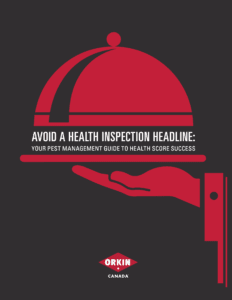When it comes to running a restaurant, a pest problem is one thing you can’t afford. Unfortunately, pests are always looking for a way inside—and once they’ve made their way in, their stealth and population growth are unmatched. Infestations can occur before you realize bugs or rodents are present, ultimately causing major consequences for your employees, your customers and your next health inspection.
Trust us, you’ll want to discover a pest problem before the health inspector does. To stop a potential issue before it starts, it’s important to conduct regular checks. Here are some of the most common areas that pests prefer to hang out:
Problem Areas
1.Receiving areas
This seems like a no-brainer, but you might be surprised how many restaurants don’t keep their receiving areas properly secured. Pests will try to hitch a ride inside with your latest shipment, look for open doors and even bury themselves inside cardboard boxes. Sealing doors, inspecting shipments and tossing away used cardboard can help strengthen your defenses on this front.
2.Storage areas
These areas are stocked with food, hidden from human view and often contain damp spots—in other words, they’re pest utopias. To keep storage space as secure as possible, make sure you sweep regularly, keep food properly sealed, dispose of old products and keep shelves at least 15 centimetres off the floor.
3. Kitchens
What’s cooking? That’s what your patrons—and pests—want to know. The kitchen is an obvious destination for crawling critters, so keep a close eye on leaking water sources, dispose of any sitting garbage, wipe down surfaces and use cleaners that fully break down food particles.
4. Dining and bar areas
Don’t let pests join your customers for a meal or a drink. Carefully clean crevices around tables and chairs, keep bar areas neat and organized and hose down any outdoor dining spaces, as these can all serve as potential gathering spots for bugs and rodents.
Conducting frequent inspections and following the tips above will help you keep pests away from your dining establishment. For more detailed tips and a full health inspection checklist, read “Avoid a Health Inspection Headline: Your Pest Management Guide to Health Score Success.”
You may also like
Canada's Top 25 Bed Bug Cities Of 2023
Bed bugs are extremely efficient hitch hikers. They can move easily across a room and climb onto luggage or anything left on a bed in just one night. Learn which cities have made Canada’s top 25 bed buggiest cities.
British Columbia's Top 20 'Rattiest' Cities 2023
As winter approaches, pest control leader Orkin Canada reminds homeowners and business owners to take precautions to help keep rodents out. Cities are ranked by the number of rodent (rat & mice) treatments the company performed from August 1, 2021 through July 31, 2022.
Ontario's Top 25 "Rattiest" Cities 2023
Pest control leader Orkin Canada reminds home owners and business owners to take precautions to help keep rodents out. Cities are ranked by the number of rodent (rat & mice) treatments the company performed from August 1, 2022 through July 31, 2023. This ranking includes both residential and commercial treatments.
Eastern Canada's Top 15 'Rattiest' Cities 2023
As winter approaches, pest control leader Orkin Canada reminds homeowners and business owners to take precautions to help keep rodents out. Cities are ranked by the number of rodent (rat & mice) treatments the company performed from August 1, 2021 through July 31, 2022.
Remove pests from your business, and stop them from coming back
We work hard to listen, understand and assess your unique situation. Request a free, no-obligation consultation today for a customized pest program that fits your needs.
Request a Free Business ConsultationRequest a Free Home Estimate


